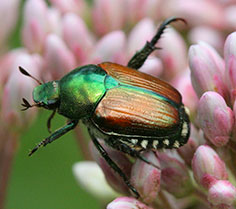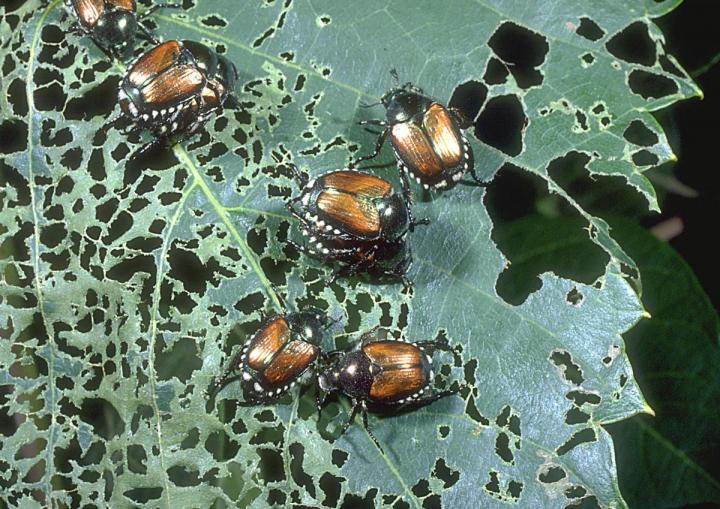Japanese Beetle

The Japanese beetle (Popillia japonica) was first discovered in the US in 1916, while state officials were inspecting a nursery in Riverton, New Jersey, about 15 miles NE of Philadelphia. By 1918 populations of the Beetle were exploding in the Riverton area. In 1920 both New Jersey and the Federal Government instituted a quarantine of the Riverton area while experimenting with poisons & parasites to control the beetle. By 1925 over 500 square miles were infested as the US government was spending over $250K per year to combat the beetle with very little success.
By 1944 the entire state of New Jersey was deemed infested with the beetle and the state wide quarantine was lifted as the battle to contain it was lost. To this day the federal government still combats the Japanese Beetle through the use of chemicals (e.g. DDT) and spraying.
Life cycle
The Japanese Beetle starts its life as a larvae about 4 to 8 inches under your lawn, where in April as the ground warms, it climbs its way up to your lawn roots where it feeds as it matures to a beetle before it tunnels its way out of the ground.
By early Summer they appear above ground as adult beetles where their diet moves on to ornamental and agricultural plant leaves.
In late August, after roughly 40 days as an adult beetle after mating the fertilized female beetles tunnels 1-3 inches into the ground to lay her eggs, usually in well maintained lawns as they find these most desirable for the next generation larvae which can take anywhere from 1 to 2 years to emerge as the next generation beetles.
Your reward for a beautiful green lawn is the next generation’s beetle larvae eating your lawn roots.


Destruction Above & Below Ground
As larvae in the ground the white grubs are pests of lawns. The growing grubs feed on grass roots causing lawn turf to brown and die. Visit our Lawn Care page for handling white grub infestation of your lawn.
As adult beetles feed on the leaves of hundreds of plants, chewing irregular holes between leaf veins, which makes the leaves resemble a piece of lace.
Japanese beetles quickly spread naturally as flying adults or as larvae when people unknowingly move sod, or soil.
Preventive Measures (Naturally)
Japanese beetles thrive in monoculture environments, where the immediate area is predominantly of only one or two plant types. If any of those few plant types are on the beetles favorite food lists, then this bountiful environment becomes a magnet for the beetles.
You can have plants on the beetles favorites list, but if the number of their favorites is small compared to the other plantings, then your garden becomes less attractive. Although you might see some beetle damage on their favorite plants, it won’t be as devastating as a garden filled with mostly beetle favorites.
Resistant Plants to Beetles
- Red Maple (Acer rubrum)
- Red Bud (Cercis spp.)
- Dogwood (Cornus spp.)
- Sweetgum (Liquidambar styraciflua)
- Begonias
- Coreopsis
- Coral Bells (Heuchera sanguinea)
- Hostas
See here for a more complete list of resistant plants.
Susceptible Plants to Beetles
- Japanese Maple (Acer palmatum)
- Crape Myrtle (Lagerstroemia indica)
- Linden (Tilia spp.)
- Plums & Cherries (Prunus spp.)
- Roses (Rosa spp.)
- Hollyhock (Alcea rosea)
- Evening Primrose (Oenothera biennis)
- Grapes (Vitis spp.)
See here for a more complete list of susceptible plants.
Manage & Control of Beetles
Physical Solutions
- Physically remove them – manually picking adult beetles from your plants reduces the natural chemical effect they cause which signals other beetles to the same feeding location. They like to rest in the sun and are easy to spot. Their default strategy if disturbed is simply to free fall until they can open their wings. Thus a simple catch method is to hold a cup of soapy water underneath the beetle and disturb it.
- Netting – using landscaping netting over susceptible plants while the adult beetles are feeding will cause them to look elsewhere.
- Landscaping with fewer Susceptible Plants – the smaller the salad bar the more likely they’ll go elsewhere.
Non-Chemical Solutions
- Soap & Water Solutions – spraying a soapy water solution on the beetles will stymie their ability to fly for a short term allowing natural predators to feast on them.
- Geraniums – plant geraniums near your susceptible plants. The geranium paralyzes the beetle for up to 24 hours, causing them to fall to the ground where they can be collected or left for predators to feast on.
- Neem Oil – works similarly to soap and water. You’ll still need to collect the fallen beetles or leave for their predators to eat.
Chemical Solutions
- Grub-Ex – kill the beetles while still larvae in the ground. Putting down Grub control in mid-Spring (when you start to see those brown patches) is the most effective management of these pests. Other chemical solutions are a threat to pollinators.
References
- Rutgers Cooperative – New Jersey Japanese Beetle Quarantine
- USDA – Japanese Beetle Management
- 7 Ways to Repel Japanese Beetles – Tom’s Guide for Japanese Beetle management
- Minnesota Cooperative Extension – Japanese Beetle Management
- Fraser Valley Rose – Youtube video on everything Japanese Beetles.

